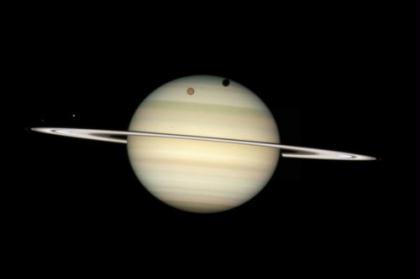NASA's Cassini spacecraft shows Saturnian roller derby
2010-03-19 08:55 BJT
WASHINGTON, March 18 (Xinhua) -- The seemingly serene orb of Saturn is in fact a gas giant with extraordinary patterns of charged particles and rough and tumble roller derbies for rings, NASA's Cassini spacecraft found since its arrival at Saturn in 2004. The findings will be published Friday in journal Science.
 |
| An image of four moons of Saturn passing in front of their parent planet in seen this image taken by NASA's Hubble Space Telescope February 24, 2009 and released by NASA March 17, 2009. In this view, the giant orange moon Titan casts a large shadow onto Saturn's north polar hood. Below Titan, near the ring plane and to the left, is the moon Mimas, casting a much smaller shadow onto Saturn's equatorial cloud tops. Farther to the left, and off Saturn's disk, are the bright moons Dione and the fainter Enceladus. (Xinhua/Reuters File Photo) |
"This rambunctious system gives us a new feel for how an early solar system might have behaved," said Linda Spilker, a planetary scientist and the new Cassini project scientist at NASA's Jet Propulsion Laboratory in Pasadena, California. "This kind of deep, rich data can only be collected by an orbiting spacecraft and we look forward to the next seven years around Saturn bringing even more surprises."
In the paper describing the elegant mess of activity in the rings, lead author Jeff Cuzzi, Cassini's interdisciplinary scientist for rings and dust who is based at NASA Ames Research Center, describes how Cassini has shown us that collisions are routine and chunks of ice leave trails of debris in their wake. Spacecraft data have also revealed how small moons play tug-of-war with ring material and how bits of rubble that would otherwise join together to become moons are ultimately ripped apart by the gravitational pull that Saturn exerts.
During equinox, the period when sunlight hits the rings exactly edge-on, Cassini witnessed rings that are normally flat -- about tens of meters thick -- being flipped up as high as the Rocky Mountains.
The spacecraft has also shown that the rings are composed mostly of water ice, with a mysterious reddish contaminant that could be rust or small organic molecules similar to those found in red vegetables on Earth.
"It has been amazing to see the rings come to life before our very eyes, changing even as we watch, being colorful and taking on a tangible, 3-D nature," Cuzzi said. "The rings were still a nearly unstructured object in even the best telescopes when I was a grad student, but Cassini has brought us an intimate familiarity with them."
Cuzzi said Cassini scientists were surprised to find such fine- scale structure nearly everywhere in the rings, forcing them to be very careful about generalizing their findings across the entire ring disk. The discovery that the rings are clumpy has also called into question some of the previous estimates for the mass of the rings because there might be clusters of material hidden inside the clumps that have not yet been measured.

 Mail
Mail Share
Share Print
Print


 Video
Video









 2009 China Central Television. All Rights Reserved
2009 China Central Television. All Rights Reserved